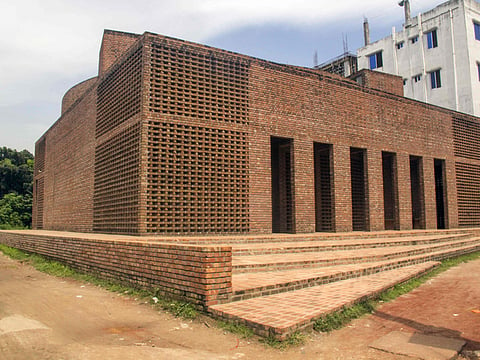Bangladeshi mosque architect smashes glass ceiling
Marina Tabassum was an unconventional choice to design Bangladesh’s new Baitur Rouf Mosque

But there is little of the conventional about the 45-year-old Tabassum or her design, which eschews traditional minarets and domes in favour of a single-storey terracotta brick structure that is suffused with light and remains cool even in the scorching summer months.
Like most women in deeply conservative Bangladesh, Tabassum had barely set foot in a mosque when she was commissioned to design the building in 2005 after her grandmother donated a piece of land.
Few of Bangladesh’s mosques have dedicated sections for female worshippers, and most women pray at home.
But Tabassum visited over 100 before setting pen to paper for the Baitur Rouf Mosque in north Dhaka, focusing on creating a haven of peace in a poor neighbourhood of one of the world’s most congested cities.
“We may not have a tradition of women going into mosques to pray in the Indian subcontinent, but I have experienced some really beautiful spiritual spaces. That has always been a great inspiration to me,” she told AFP in a recent interview.
“The whole idea of spirituality as an element in design has always been something very intriguing and I like working with spiritual spaces.”
The 45-year-old, who emerged as one of Bangladesh’s top architects after designing Dhaka’s Museum of Independence, says her sex has not constrained her career.
“I think of myself as a professional. This whole notion of me being a woman really does not exist in my mind. It just does not exist,” she said.
‘Natural air conditioning’
The Aga Khan Award for Architecture is handed out every three years and rewards excellence in architecture serving Muslim communities. This year the $1 million prize was shared between six projects around the world.
The jury said the Dhaka mosque “challenges the status quo”, praising its “robust simplicity that allows for deep reflection and contemplation in prayer”.
Officially secular but mainly Muslim Bangladesh has a rich history of mosque building, dating back to the Turkish invasion of the 13th century.
The earliest combined their own designs with elements found in local traditions, such as the use of brick and small domes that span the roof, creating a unique style.
Tabassum said she tried to fuse those “glorious lost traditions” of mosque design with contemporary architectural practices.
Since it was completed in 2012, the Baitur Rouf Mosque has attracted visitors from around the country - to the obvious delight of the imam, Deen Islam.
“Unlike other mosques in the country, it does not have a minaret, or a dome, or a platform to deliver Friday prayers. Yet to these visitors it is one of the most beautiful mosques of the country,” the 38-year-old imam told AFP on a recent visit.
“The mild light that enters the mosque is very soothing. Even during a hot summer day, the temperature inside remains mild. You feel like you’re in natural air conditioning.”
Dozens of tiny windows in the roof and walls create a soft light that changes through the day as the sun passes over the building, while the traditional terracotta bricks keep the interior cool.
Tabassum also teaches architecture students and says she is highly selective about the projects she takes on, and every one must have some social value.
“We are a very young nation and an architect’s responsibility goes beyond just designing beautiful buildings,” she said.
“We can design buildings like the ones designed by Frank Gehry. But I would question whether that would be the right thing to do in a country like Bangladesh, whose economy is still not developed.
“In the Bangladesh context, that would be an ugly thing to do.”
Sign up for the Daily Briefing
Get the latest news and updates straight to your inbox



